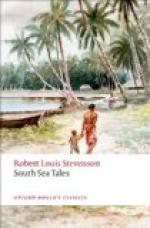Under the eastern shore, our schooner, now bereft of any breeze, continued to creep in: the smart creature, when once under way, appearing motive in herself. From close aboard arose the bleating of young lambs; a bird sang in the hillside; the scent of the land and of a hundred fruits or flowers flowed forth to meet us; and, presently, a house or two appeared, standing high upon the ankles of the hills, and one of these surrounded with what seemed a garden. These conspicuous habitations, that patch of culture, had we but known it, were a mark of the passage of whites; and we might have approached a hundred islands and not found their parallel. It was longer ere we spied the native village, standing (in the universal fashion) close upon a curve of beach, close under a grove of palms; the sea in front growling and whitening on a concave arc of reef. For the cocoa-tree and the island man are both lovers and neighbours of the surf. ’The coral waxes, the palm grows, but man departs,’ says the sad Tahitian proverb; but they are all three, so long as they endure, co-haunters of the beach. The mark of anchorage was a blow-hole in the rocks, near the south-easterly corner of the bay. Punctually to our use, the blow-hole spouted; the schooner turned upon her heel; the anchor plunged. It was a small sound, a great event; my soul went down with these moorings whence no windlass may extract nor any diver fish it up; and I, and some part of my ship’s company, were from that hour the bondslaves of the isles of Vivien.
Before yet the anchor plunged a canoe was already paddling from the hamlet. It contained two men: one white, one brown and tattooed across the face with bands of blue, both in immaculate white European clothes: the resident trader, Mr. Regler, and the native chief, Taipi-Kikino. ‘Captain, is it permitted to come on board?’ were the first words we heard among the islands. Canoe followed canoe till the ship swarmed with stalwart, six-foot men in every stage of undress; some in a shirt, some in a loin-cloth, one in a handkerchief imperfectly adjusted; some, and these the more considerable,




